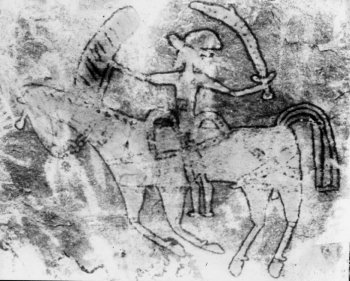Origin and Development of the Memorials
by K. L. Kamat
During old stone (upper Paleolithic) age, man invented stone implements which helped him to develop cave and rock shelter sculpture and painting. He drew on the walls of the shelters in order to appease bad spirits, success in the hunt combat, cure the sick and wounded. This practice might have led him to draw for the dead so that the deceased's spirits do not haunt them. In a Pachmadi cave painting, of a burial ceremony, the disheartened family is effectively drawn. The burial practice of the period has a close resemblance to that of present day tribals. The stone-age man used to bury the dead along with his worldly possessions, such as ornament, snail shells and even his long-lost tooth. The skulls found in these Neolithic graves show a genetic relation to present day Korku-Gond tribes. This gives inking that the custom of erecting memorials originated in the Paleolithic period.
Evolution
When these aboriginals acquired enough skill to hunt, fish, construct hut and grow food, they left the caves and rock shelters to live in plains and river beds. Absence of ritualistic art in this period indicates that for a while they had to forego it. In between, if they had developed one or other from of memorial art, such as wood carving, they are completely lost for the posterity.
In the new environment the aboriginals might have employed boulder type a memorials and sacrificed some of domesticated animals to appease the dead. All other forms appear to have evolved from this basic form. Buddhists as early as 300 B.C. adapted this and developed into the stupa form. Phallic, pillar, tomb and temple types are also its derivatives. The Tulsi-like memorials might have been specially evolved and dedicated to deceased priests and holy men.
At the dawn of history, specialized people with special tools became available for specific jobs. Thus dressing up of the granite boulder into a pillar and later carving it with elaborate motifs resulted into eighth century Hindu memorials. The granite slab seems to be the next logical step in the evolution. It is very significant that these are mostly restricted to Bastar district from where this art might have percolated into Andhra Pradesh and Karnataka. Almost all the memorials of Karnataka seem to be derivative of this form. Even Nishidi and Sati memorials are in conformity with his hypothesis. Existence of this custom among people of Dravidian origin and almost its absence among Aryans indicated its tribal origin. When the aboriginals commenced their migration to the south, in order to avoid the foreign invasions, they might have brought this custom with them.
© K. L. Kamat

Rock Shelter Painting
Adamgad in Hosangabad District
Size: 2 1/2 feet X 2 feet
When the sculptors became scarce and sculpturing became expensive, people might have opted for carved wood memorials. In Bastar where wood is abundant, they went in for the pillar type, whereas the eastern tribals preferred less expensive plank memorials. Korkus even today imitate their ancestral art which is at least six thousand years old. Some of the rock-shelter paintings resemble very closely the memorial art of Korkus. A man riding a horse with the servant following him with a decorated umbrella, as depicted in rock painting, indicates his higher status. Korkus do not rear any horses but their dead man always riders a horse. This might be a vestige of their ancestral style that remained unchanged in the last six thousand years! The painted memorials might be just an offshoot of sculptured granite.
Anthropologist Verrier Elwin suggests that erecting the memorials among tribals might have been a borrowed custom from Hindus. On the contrary, the facts available indicate that Hindus might have inherited this practice from their tribal ancestors.
Memorials of Madhya Pradesh
Origins | Distribution | Installation
Non-illustrated Memorials | Illustrated
| Wooden
Sculpted & Painted Memorials | Religious
References

